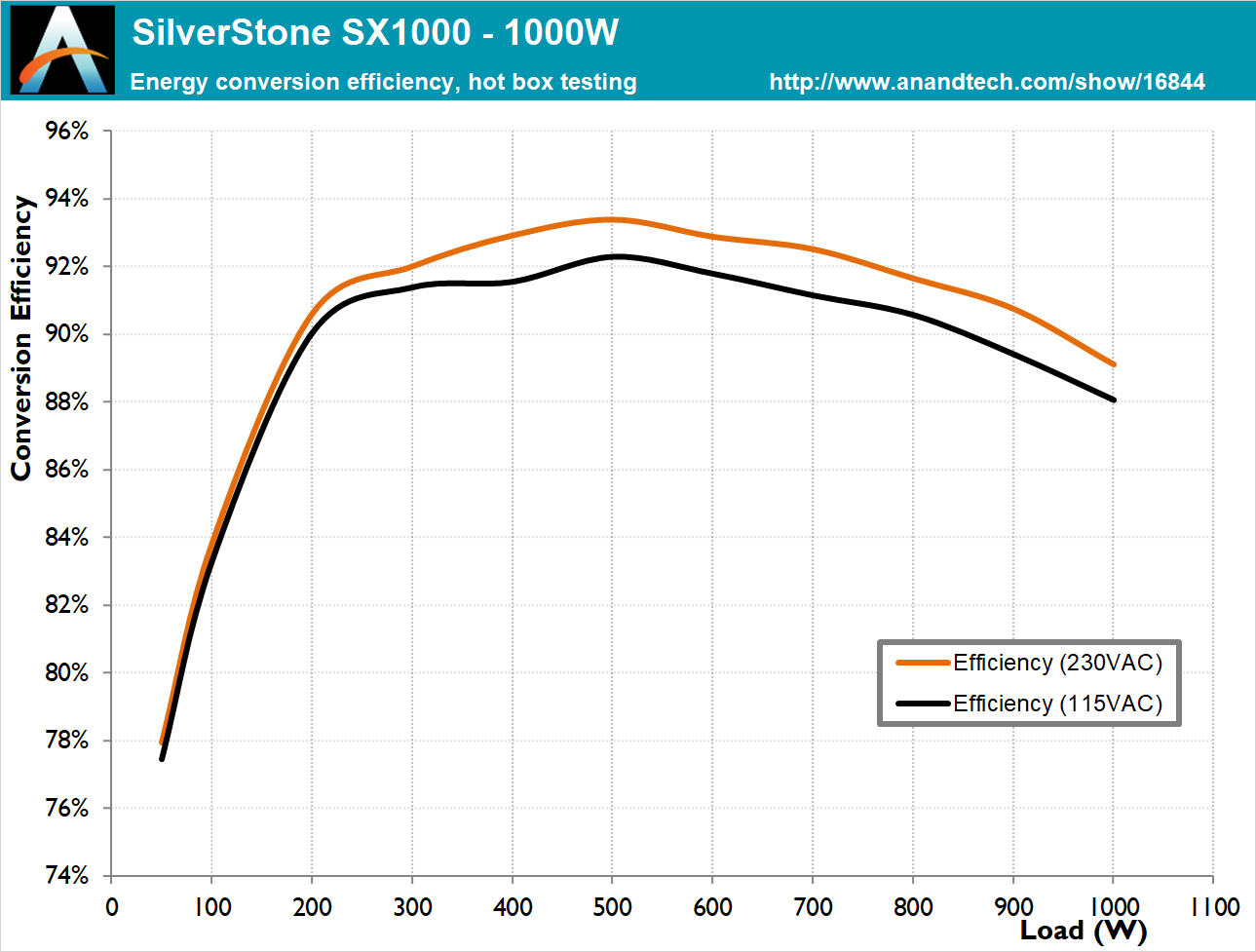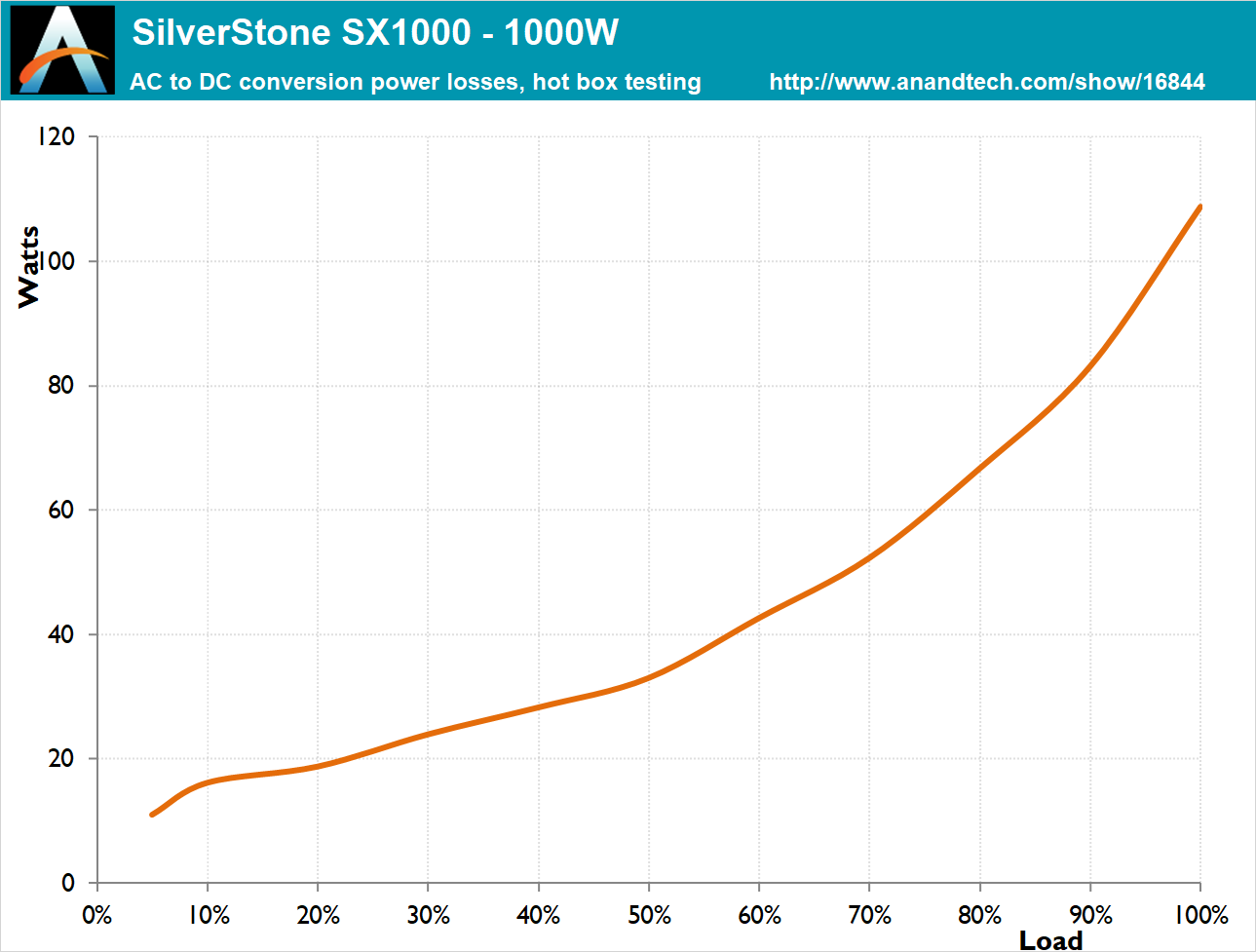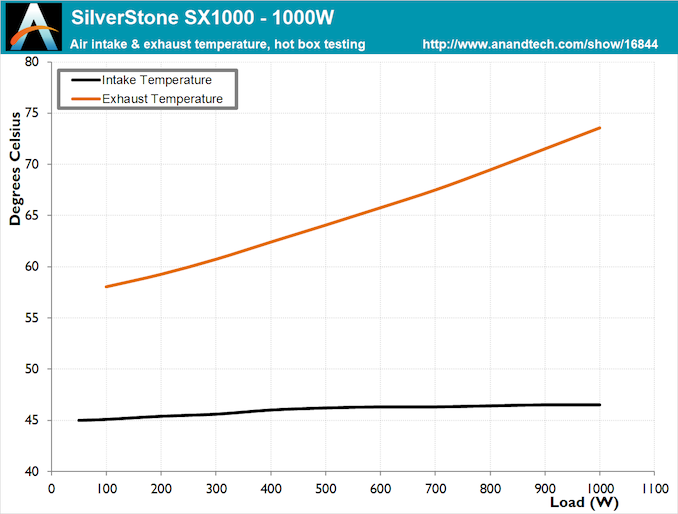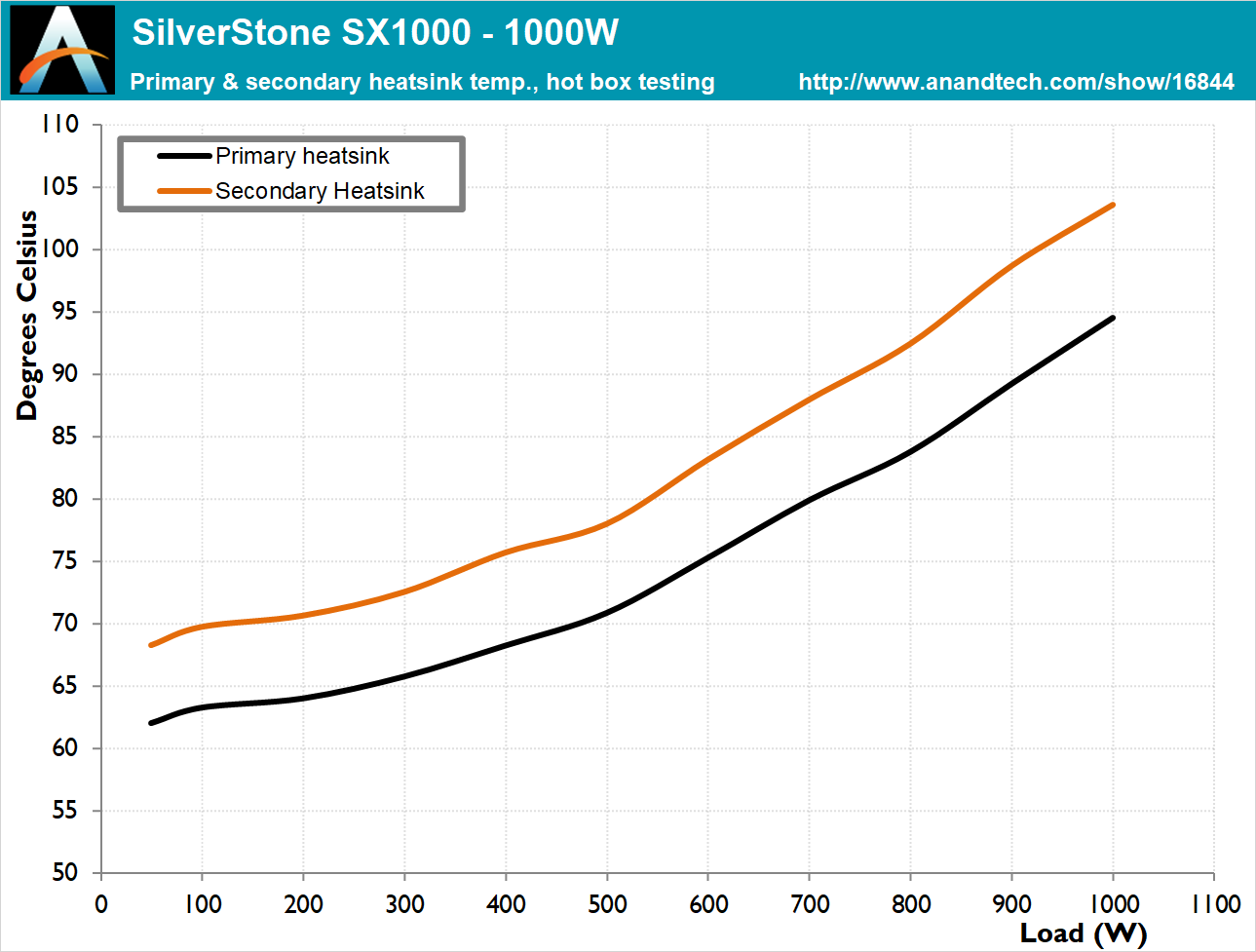The SilverStone SX1000 SFX-L 1 kW PSU Review: Big Power for Small Form Factors
by E. Fylladitakis on July 28, 2021 9:00 AM EST- Posted in
- Cases/Cooling/PSUs
- PSUs
- SilverStone
- SFX
- SFX-L
Hot Test Results (~45°C Ambient)
For the testing of PSUs, we are using high precision electronic loads with a maximum power draw of 2700 Watts, a Rigol DS5042M 40 MHz oscilloscope, an Extech 380803 power analyzer, two high precision UNI-T UT-325 digital thermometers, an Extech HD600 SPL meter, a self-designed hotbox and various other bits and parts. For a thorough explanation of our testing methodology and more details on our equipment, please refer to our How We Test PSUs - 2014 Pipeline post.
The SX1000 is designed to deliver its advertised performance with an ambient temperature of up to 40°C, a bit cooler than our standard 45°C hotbox. Although the unit did operate inside the hotbox without significant issues and did not shut down even at maximum load, there were significant signs of thermal stress. Naturally, the energy conversion efficiency takes a hit, dropping an average of almost 1% across the load range. The drop, however, is not equally distributed, as the SX1000 is almost just as efficient as it was outside the hotbox until the load reaches 40%, then the efficiency degrades as the load increases, and the efficiency drop is almost 1.7% at maximum load. This suggests that the components are getting significantly thermally stressed – which is to be expected, looking at the internal temperatures of the unit.
Rarely ever we see temperatures greater than 100 °C inside a PSU, either because their cooling is sufficient or because their thermal protection circuitry will shut them down. Neither was true for the SX1000, as the temperature did surpass 100 °C under maximum load with the unit operating inside our hotbox. Still, the SX1000 stayed in operation and performed within the expected parameters, even though it was clearly on the verge of shutting down due to thermal overload.
Even though we would expect the fan of the SX1000 to start almost immediately inside our hotbox, it actually did not. The thermal circuitry started the fan when the load reached 100 Watts, meaning that the SΧ1000 should stay dead silent with the PC idling even inside a very hot enclosure. Still, once the load increases even slightly above that point, the fan will start and its speed will start increasing sharply, as the SX1000 is trying to cope with the thermal load in these adverse conditions. It reaches its maximum speed when the load is just 400 Watts, with the sound pressure levels being very high at this point. With the fan unable to do anything more for the cooling needs of the SX1000, the internal temperatures reach uncomfortably high levels when the PSU is heavily loaded under such operating conditions.















37 Comments
View All Comments
romrunning - Wednesday, July 28, 2021 - link
You can't just generalize that all small form factor PSUs are not worth it. A good PSU is a good PSU, no matter what size. I have a Corsair 750W SFX PSU, and it's perfectly fine and quiet, despite the SFX size. I do not feel I have compromised in any way compared to a full-size ATX 750W, and indeed, I have benefited from the small size in my ITX case. I think all PSUs, large and small, should be judged by their own strengths & weaknesses.Oxford Guy - Wednesday, July 28, 2021 - link
There is a thing called diminishing returns. The laws of physics can’t be broken via wishful thinking.Taking one aspect of design far out causes necessary curtailment(s). If those are something a person can live with (such as a deaf person with a loud PSU) that’s fine but the more niche a design is the less appeal/relevance it will have for the majority.
Three-wheel microcars have their niche but it’s not a very big one, no matter how ‘good’ they are. Don’t try to drive them at high speeds and don’t expect much if there is a collision with a larger vehicle. They’re fine when they ‘stay in their lane’. No one is going to put a V-8 turbodiesel into one.
CheapSushi - Thursday, July 29, 2021 - link
This is NOT diminishing returns. This is so stupid as a comment. There's even smaller form factors. With Gallium Nitrate they get even more efficient. They get quieter because of higher efficiency. More can be titanium and platinum rated. Seasonic even makes a dual twin 700W PSU in an ATX form factor. Stop holding back the norm. People like you would never let the Industry do ANYTHING different.Oxford Guy - Thursday, July 29, 2021 - link
Putting the word 'not' in caps isn't a substantive rebuttal, nor is the rest of your post.Higher efficiency is available in larger form factors. And... the maximum size of the fan decreases as form factors shrink – something this article pointed out. Smaller fans make more noise for the same level of cooling, typically, if two fans are designed equally efficiently. That is why ATX cases no longer commonly ship with 80mm fans.
'Stop holding back the norm. People like you would never let the Industry do ANYTHING different.'
Good ole ad hom... the lubricant of astroturf.
Samus - Thursday, July 29, 2021 - link
What compromise? Not everyone needs a big case to flex their e-peen :)CheapSushi - Thursday, July 29, 2021 - link
What's that got to do with anything? Case size shouldn't be the deciding factor for making SFX and SFX L the norm, the standard. Silverstone and many others are proving you can make high efficiency high watt in a smaller package with zero real loss to anything in quality and performance.Oxford Guy - Thursday, July 29, 2021 - link
Oh my. Well... you managed to respond to a bad comment with one that was even less competent.Oxford Guy - Wednesday, July 28, 2021 - link
‘This is a strange choice by SilverStone, as the company usually prefers to use sleeve bearing fans because of their lower noise output, even for their top-tier products.’Sleeve bearing fans have to be mounted vertically for good longevity, according to everything I’ve read. PSUs are always mounted horizontally.
Sleeve bearings are also, as far as I know, efficient with no/very low restriction scenarios (e.g. ‘case’ ‘airflow’ fans) but create very little static pressure. So, using a sleeve fan inside a PSU hardly seems optimal in that way either. Should designers begin to mount them vertically...
FDB and similar ‘modern’ bearings seem to be optimal from both a cooling-per-decibel point of view (with decent, although not always great, static pressure ability) and also can be mounted horizontally.
Ball bearing fans typically are used for the highest static pressure scenarios, such as mounted to dense radiators. How much less restriction does a PSU like this one have?
meacupla - Thursday, July 29, 2021 - link
The bearing type has little to no factor in determining static pressure or air flow of the fan.Sleeve bearing fans just don't last as long as ball bearings, especially in higher temperatures.
There is a NMB comparison sheet even tells you that sleeve bearings will fail to operate above 70c.
"Sleeve bearing is quieter" is an outdated convention. Well made ball bearings can run as quiet as sleeve bearings, but cost goes up with tighter tolerances.
The reason for most static pressure fans using ball bearings or fluid dynamic bearings, is probably because they already require tighter manufacturing tolerances, and using higher quality bearings doesn't increase the BoM by much.
Where as air flow fans can be made cheaply by skimping on quality and using a sleeve bearing to compensate for the increased noise of poor weight balance.
Oxford Guy - Thursday, July 29, 2021 - link
'The bearing type has little to no factor in determining static pressure or air flow of the fan.'I have never seen a sleeve fan that has strong static pressure but I have seen plenty of dual-bearing ball fans that do. They have little space between the blades and, typically, large motor hubs.
I have read a lot of fan reviews and the review results don't match your claims, nor the claims of Samus. I have also purchased a good number of fans and have looked at what's on offer at retail and online. These magical sleeve-bearing static pressure fans are like unicorns.